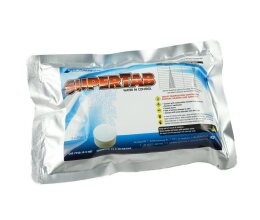

Finite element methods include finite element Lax-Wendroff schemes, implicit Galerkin method, mixed variational principles, dual iterative procedures, optimal control methods and least squares.įinite-element three-dimensional ground-water (FE3DGW) flow model - formulation, program listings and users' manual Finite difference methods considered include time-dependent methods, relaxation methods, semidirect methods, and hybrid methods.

#Supertab chlordioxid full
The forms of the governing equations for unsteady two-dimensional transonic flow considered are the Euler equation, the full potential equation in both conservative and nonconservative form, the transonic small-disturbance equation in both conservative and nonconservative form, and the hodograph equations for the small-disturbance case and the full-potential case. The paper reviews the chief finite difference and finite element techniques used for numerical solution of nonlinear mixed elliptic-hyperbolic equations governing transonic flow. (Author 's abstract)įinite elements and finite differences for transonic flow calculations Varying the flux variables representing discharge at Franklin Lake and Furnace Creek Ranch has greater effect than varying other flux variables.

Sensitivity analyses of the model 's flux boundary condition variables were performed to assess the effect of varying boundary fluxes on the calculation of estimated model transmissivities.

Model residuals for simulated versus measured hydraulic heads range from -28.6 to 21.4 m most are less than +/-7 m, indicating an acceptable representation of the hydrologic system by the model. Simulated hydraulic-head values range from about 1,200 m near Timber Mountain to about 300 m near Furnace Creek Ranch. Three model parameters were used in estimating transmissivity in six zones. Hydraulic gradients in the modeled area range from 0.00001 for carbonate aquifers to 0.19 for barriers in tuffaceous rocks. The model simulated steady-state ground-water flow occurring in tuffaceous, volcanic, and carbonate rocks, and alluvial aquifers. Provided in the Supplemental Data section are a listing of the computer program, definitions of selected program variables, and several examples of data input and output used in verifying the accuracy of the program.įinite-element simulation of ground-water flow in the vicinity of Yucca Mountain, Nevada-CaliforniaĪ finite-element model of the groundwater flow system in the vicinity of Yucca Mountain at the Nevada Test Site was developed using parameter estimation techniques. A concise discussion of the Galerkin method is presented along with a description of the program. Results of the program compare well to analytical solutions and simulations. The computer program was developed for the preliminary simulation of ground-water flow in the Edwards-Trinity Regional aquifer system as part of the Regional Aquifer-Systems Analysis Program. Constant head, constant flux, and head-dependent flux boundary conditions can be specified in order to approximate a variety of natural conditions, such as a river or lake boundary, and pumping well. The program may also be used for unconfined aquifers of constant saturated thickness. (Kosco-USGS)Ī finite-element model for simulation of two-dimensional steady-state ground-water flow in confined aquifersĪ computer program based on the Galerkin finite-element method was developed to simulate two-dimensional steady-state ground-water flow in either isotropic or anisotropic confined aquifers. Geological Survey in cooperation with the San Bernardino Valley Municipal Water District. It was prepared as part of the investigations made by the U.S. The documentation assumes that the reader is familiar with the physics of ground-water flow, numerical methods of solving partial-differential equations, and the FORTRAN IV computer language. Geological Survey) for use in ground-water investigations in southern California. This report documents a finite-element model for simulation of ground-water flow in a two-aquifer system where the two aquifers are coupled by a leakage term that represents flow through a confining layer separating the two aquifers. Documentation of a finite-element two-layer model for simulation of ground-water flow


 0 kommentar(er)
0 kommentar(er)
